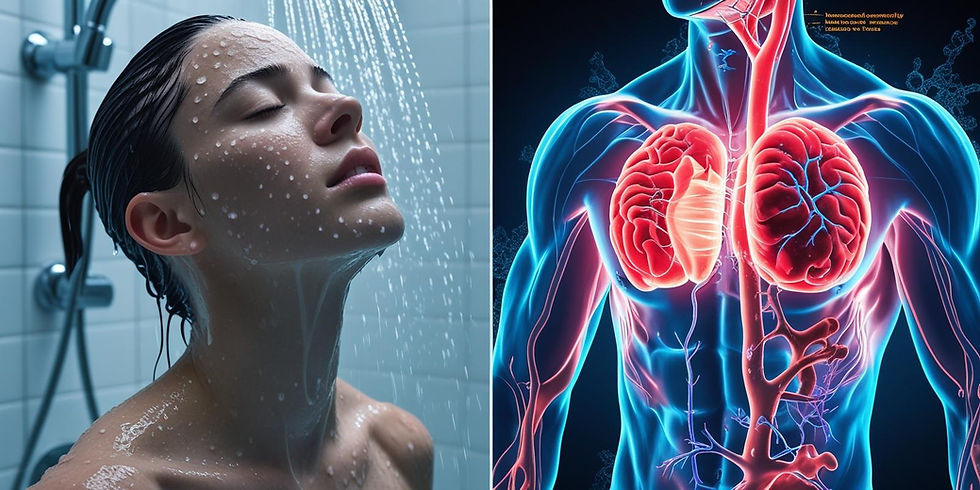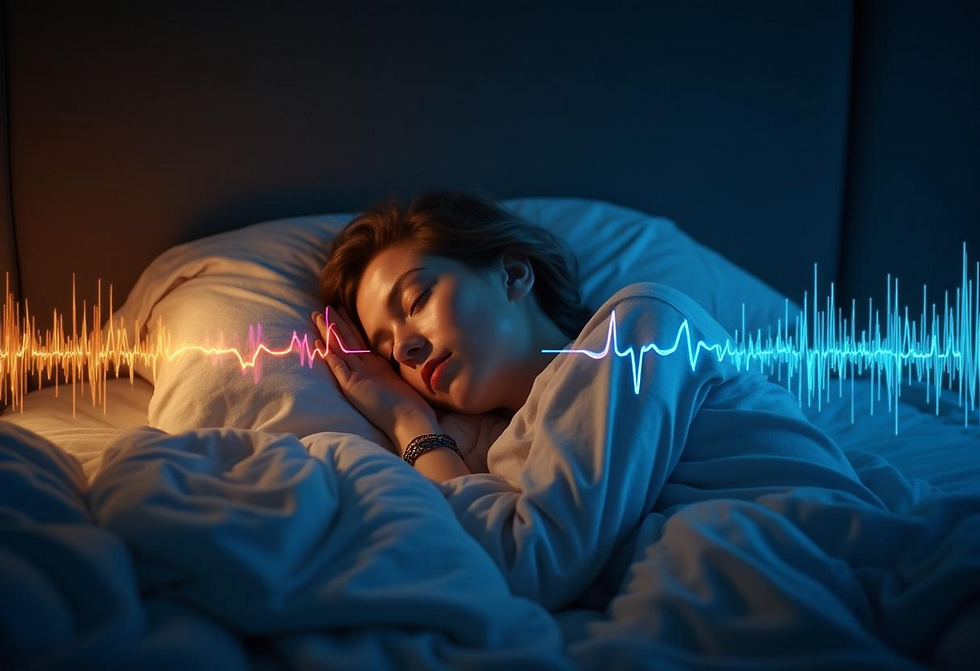The Power of Cold Showers
- MindSpaceX

- Sep 2
- 6 min read

The sound of chattering teeth and sharp inhales might not seem like the soundtrack to improved health, but what if those moments of discomfort could transform your physical performance and mental wellbeing? Cold therapy, particularly in the accessible form of cold showers, has emerged from ancient tradition into the spotlight of modern science as a powerful tool for optimizing human performance.
From elite athletes like Wim Hof and Michael Phelps to Silicon Valley executives, the practice of intentional cold exposure is gaining momentum not as a passing trend, but as a scientifically-validated method for enhancing recovery, strengthening immunity, and building mental resilience. This article explores the surprising power of turning your shower knob to the blue side and how this simple daily habit could significantly upgrade your performance in all areas of life.
Background & Context
Cold therapy isn't new—it's ancient. Historical records show cold water immersion practices dating back thousands of years across multiple civilizations. The Romans built frigidarium chambers in their bathhouses specifically for cold water immersion following heat exposure. Similarly, Nordic countries have long traditions of alternating between sauna heat and ice-cold water or snow, while traditional Japanese practice includes misogi, ritual cold water purification.
What's changed is our scientific understanding of why these traditions deliver such profound benefits. Cold therapy, also known as cryotherapy, encompasses various methods of exposing the body to cold temperatures, including ice baths, cold water immersion, cryotherapy chambers, and the most accessible option: cold showers.
The fundamental principle behind cold therapy is hormesis—the biological phenomenon where exposure to a mild stressor (in this case, cold) triggers adaptive responses that ultimately strengthen the organism. This concept is similar to how exercise works: the controlled stress of physical exertion prompts the body to adapt and grow stronger.
Expert Analysis & Insights
The Physiological Impact of Cold Exposure
Dr. Susanna Søberg, author of "Winter Swimming," has conducted extensive research on cold exposure effects. Her studies published in Cell Reports Medicine show that regular cold water immersion activates brown adipose tissue (brown fat), which burns energy to produce heat, potentially improving metabolic health.
"Just 11 minutes of cold water immersion per week can significantly increase brown fat activity and improve insulin sensitivity," notes Dr. Søberg. Her research demonstrated a 7.5% increase in brown fat volume after six weeks of regular cold exposure.
A 2020 study published in PLOS ONE found that regular cold showering was associated with a 29% reduction in sickness absence from work. Researchers attribute this to the "fight or flight" response triggered by cold exposure, which activates immune-boosting mechanisms.
Mental Performance Benefits
The psychological impact of cold therapy is equally impressive. A 2018 study in the International Journal of Environmental Research and Public Health found that cold water immersion significantly reduces levels of cortisol, the body's primary stress hormone.
Dr. Rhonda Patrick, biochemist and expert in nutritional health, explains: "Cold exposure triggers norepinephrine release, which acts as both a neurotransmitter and hormone. This molecule plays a crucial role in focus, attention, and mood regulation."
This is supported by a study from Virginia Commonwealth University, which found that brief cold showers may stimulate the locus coeruleus, triggering release of norepinephrine—potentially providing an antidepressant effect. Participants reported sustained mood improvements for up to two hours following cold exposure.
Athletic Recovery Applications
Elite athletes have long used cold therapy for performance enhancement. A meta-analysis published in the British Journal of Sports Medicine reviewed 17 studies and found that cold water immersion reduced muscle soreness by 20% compared to passive recovery methods when measured 24, 48, and 72 hours after exercise.
Olympic swimmer Michael Phelps routinely used ice baths during training, while NBA star LeBron James reportedly spends up to $1.5 million annually on body maintenance, including regular cryotherapy.
Dr. Jonathan Leeder, physiologist at the English Institute of Sport, notes: "Cold water immersion works primarily by reducing inflammation through vasoconstriction and by slowing metabolic processes in the affected tissues, potentially limiting secondary damage."
Real-World Examples
The Wim Hof Phenomenon
Perhaps no one has popularized cold therapy more than Wim Hof, the Dutch extreme athlete nicknamed "The Iceman." Hof has demonstrated remarkable abilities, including climbing Mount Kilimanjaro in shorts and setting Guinness World Records for ice immersion.
More significantly, Hof's methods were subjected to scientific scrutiny in a groundbreaking 2014 study published in the Proceedings of the National Academy of Sciences. Researchers at Radboud University found that participants trained in Hof's breathing and cold exposure techniques could voluntarily influence their autonomic nervous system and immune response—previously thought impossible.
Everyday Practitioners
Beyond elite athletes, cold therapy has found a home in mainstream wellness practices. Scott Carney, investigative journalist and author of "What Doesn't Kill Us," initially set out to debunk Hof's methods but became a convert after experiencing benefits firsthand.
"After six months of cold showers and occasional ice baths, my energy levels improved dramatically, and I haven't had a cold or flu since starting," Carney reports. "The most unexpected benefit was mental clarity—I found my focus and productivity significantly enhanced on days following cold exposure."
Silicon Valley has embraced cold therapy as a biohacking technique. Jack Dorsey, former CEO of Twitter, has spoken about his morning routine including ice baths, while venture capitalist Tony Robbins reportedly immerses in 57-degree water each morning.
Alternative Perspectives
Not all research supports cold therapy's benefits, particularly for athletic recovery. A 2017 study in the Journal of Physiology found that regular post-training cold water immersion actually blunted muscle adaptations to resistance training over a 12-week period.
Dr. Llion Roberts, one of the study's authors, cautions: "If your primary goal is muscle hypertrophy, cold water immersion immediately post-strength training may be counterproductive by interfering with protein synthesis and satellite cell activity."
Additionally, people with certain health conditions—including cardiovascular disease, Raynaud's syndrome, or compromised immune function—should consult healthcare providers before beginning cold therapy practices.
Dr. Clare Eglin from the University of Portsmouth warns about cold shock response: "Sudden immersion in cold water can cause gasping, hyperventilation, and increased heart rate, potentially dangerous for those with underlying health issues."
Practical Takeaways & Future Outlook
How to Safely Incorporate Cold Showers
Start gradually: Begin with your normal shower, then finish with 15-30 seconds of cold water. Gradually increase cold exposure time.
Focus on breathing: Practice slow, controlled breaths during cold exposure to manage the shock response.
Consistency trumps intensity: Daily brief cold exposure shows more benefits than occasional lengthy sessions.
Post-exercise timing: For recovery benefits, use cold exposure within 30 minutes after training. For muscle growth, consider waiting 3-4 hours after strength training.
Monitor your response: Track energy levels, sleep quality, and recovery to personalize your approach.
The Future of Cold Therapy Research
Emerging research suggests cold therapy may have applications beyond performance enhancement. A 2021 study in Nature Communications indicates that controlled cold exposure might increase production of adiponectin, a protein that helps regulate glucose levels, potentially benefiting metabolic health.
Dr. Susanna Søberg predicts: "Within the next decade, we'll likely see cold exposure protocols prescribed alongside traditional treatments for mood disorders, metabolic syndrome, and inflammatory conditions."
There You Have It...
Cold therapy, accessible through something as simple as adjusting your shower temperature, offers a remarkable range of potential benefits—from enhanced physical recovery and immune function to improved mental clarity and stress resilience. By understanding the science behind this ancient practice and implementing it strategically, you can tap into a powerful, cost-free tool for optimizing your performance.
The most valuable aspect of cold therapy may be its ability to build mental toughness through voluntary discomfort. As Wim Hof often says, "The cold is merciless but righteous." Each shiver-inducing shower represents a small victory over comfort-seeking instincts, potentially strengthening your capacity to face life's inevitable challenges.
Ready to explore more cutting-edge approaches to optimizing your mental and physical performance? Visit MindSpaceX.com for related articles, science-backed courses, and expert guidance on integrating cold therapy and other performance-enhancing practices into your daily routine.
References
Søberg, S., et al. (2021). "Winter swimming improves metabolic health via brown adipose tissue activation." Cell Reports Medicine, 2(4).
Buijze, G.A., et al. (2016). "The Effect of Cold Showering on Health and Work: A Randomized Controlled Trial." PLOS ONE, 11(9).
Shevchuk, N.A. (2008). "Adapted cold shower as a potential treatment for depression." Medical Hypotheses, 70(5), 995-1001.
Kox, M., et al. (2014). "Voluntary activation of the sympathetic nervous system and attenuation of the innate immune response in humans." Proceedings of the National Academy of Sciences, 111(20), 7379-7384.
Roberts, L.A., et al. (2015). "Post-exercise cold water immersion attenuates acute anabolic signalling and long-term adaptations in muscle to strength training." Journal of Physiology, 593(18), 4285-4301.
.png)














Comments